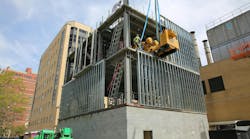Beginning in 2014, large commercial buildings in Minneapolis must report energy and water use annually to comply with a new ordinance city leaders approved recently intended to increase energy awareness. The ordinance is a tool that uses market forces, rather than performance or design mandates, to motivate owners and tenants to invest in efficiency improvements, ultimately saving energy, lowering energy costs, reducing pollution and spurring local green jobs. Commercial buildings account for roughly 35% of greenhouse gas pollution in Minneapolis.
“This ordinance acknowledges that buildings have a tremendous impact on greenhouse gas pollution,” said Mayor R.T. Rybak. “The long-term intent is to work toward city targets around reducing greenhouse gas pollution while supporting the potential for energy savings, local economic activity and local green jobs.”
“This kind of transparency builds on our strengths in Minneapolis around energy efficiency,” said Council Member Elizabeth Glidden, author of the ordinance and chair of the Regulatory, Energy and Environment Committee. “Other cities’ experiences with disclosure requirements are showing that they will result in lower energy costs for businesses.”
The City of Minneapolis and other public entities will lead by example and begin publicly disclosing energy and water use in their buildings larger than 25,000 square feet starting in 2013. Private commercial buildings larger than 100,000 square feet will begin reporting June 1, 2014, and publicly disclosing in 2015, and private commercial buildings larger than 50,000 square feet will begin reporting June 1, 2015, and publicly disclosing in 2016.
The required free software, the U.S. Environmental Protection Agency’s Portfolio Manager, measures the building’s energy and water performance and generates a score and other metrics, similar to a fuel economy rating on a vehicle. The system takes into account such information as building age, operating hours, workers per square foot, occupancy rates and space usage. (Scoring models assume buildings with higher intensities of activities use more energy; more intense uses do not necessarily result in lower scores.)
The city will partner with the Center for Energy and Environment to offer training for building owners starting in early 2014, before the first reporting deadline. The Center for Energy and Environment is a nonprofit that specializes in commercial energy efficiency solutions. A city website will guide building owners and managers through what is needed to comply and how to use the required software. While the City does not require energy efficiency improvements, it will guide building owners toward rebates and loans for retrofits.
Cities that already have this requirement include Austin, Texas; New York; Philadelphia; San Francisco; Seattle; and Washington, D.C.
For more information, including the complete ordinance, visit www.minneapolismn.gov/environment/index.htm.



